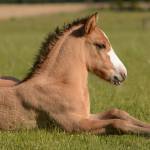Tips for Feeding the Orphaned Foal

Despite the best preparation and the highest level of care from mare owners, foals are occasionally orphaned. How to proceed nutritionally depends on the age of the foal at the time of loss or rejection.
Colostrum
Colostrum, known also as “first milk,” provides foals with essential antibodies that are critical for the development of the immune system. Colostrum must be ingested within the first 24 hours of life, and ideally within the first 12 hours. After 24 hours, the immunoglobulins are too large to be absorbed by the digestive system. For this reason, colostrum is one of the most important meals for foals. Because of its importance, it is wise to store extra colostrum from mares that have previously produced high-quality colostrum, which can be frozen and stored for up to two years. Preparation is key, as finding colostrum in an emergency can be difficult.a
Milk
After ingestion of colostrum, foals require a continuous supply of milk. Commercially available milk replacers specifically formulated for foals are an option. Alternatively, unmodified goat’s milk or 2% cow’s milk with 20 g/l of dextrose (not sucrose) added can be used. Foals need to consume small, frequent milk meals hourly for the first two days of life, and every two hours over the next 12 days. Meal frequency can be gradually reduced so that by eight weeks of age the foals are fed four times daily. Training foals to drink from a bucket early on will reduce the labor involved in ensuring sufficient feeding and will also allow them to drink at they choose.a,b
Once foals are trained to drink from a bucket, “it’s important to clean milk buckets once or twice per day, replacing with freshly mixed milk replacer each time,” said Catherine Whitehouse, M.S., a nutrition advisor with Kentucky Equine Research. “Not only does this strategy keep fresh replacer in front of the foals, it’s also more hygienic for foals that could be predisposed to immune challenges.”
Nurse Mares
Think of nurse mares as adoptive moms. Locating a nurse mare is the first challenge, and having her accept a foal is the second. While some farms specialize in supplying nurse mares to mare owners, numerous internet groups have also facilitated the placement of wet, or in-milk, mares in homes that have orphaned foals. Cooperation between mare and foal owners is typically a win-win situation.
Keep in mind, however, that it can take days or even one to two weeks for the nurse mare to acclimate to the foal, and slow, careful introduction is always necessary. Assuming all goes well, nurse mares are an ideal option especially for foals less than 6-8 weeks of age. Naturally, one-week old foals will nurse 5-8 times per hour (depending on age), which is not practical under hand-rearing circumstances. The surrogate mom can take over frequent feeding duties and provide horse-to-horse bonding, also important for socialization.a,b,c,
Creep Feeding
Feeds designed for broodmares typically contain grains and sucrose, which cannot be digested by the young foal. Therefore, foals under three to four months of age should have access to a milk-based creep feed, which is commercially available, and can be introduced after the first week or so of life. Beyond three or four months of age, a commercial feed designed for growth can be slowly introduced.a
Getting the right start with proper nutrition is essential for foals, even in difficult circumstances. With proper management and extra care, orphan foals can grow to their full potential.
The nutrition advisors at Kentucky Equine Research can help answer specific questions about feeding foals, including those that have been orphaned. Contact the team today!
aStoneham, S.J. 2013. Feeding orphan and sick foals. In: Equine Applied and Clinical Nutrition. Geor, R.J., P.A. Harris, and M. Coenen (Eds). Saunders Elsevier, London, 618-627.
bParadis, M.R. 2012. Feeding the orphan foal. In: Proc. AAEP Convention, 58:402-406.
cMowry, B. 2014. Feeding orphan foals. eXtension.org.








